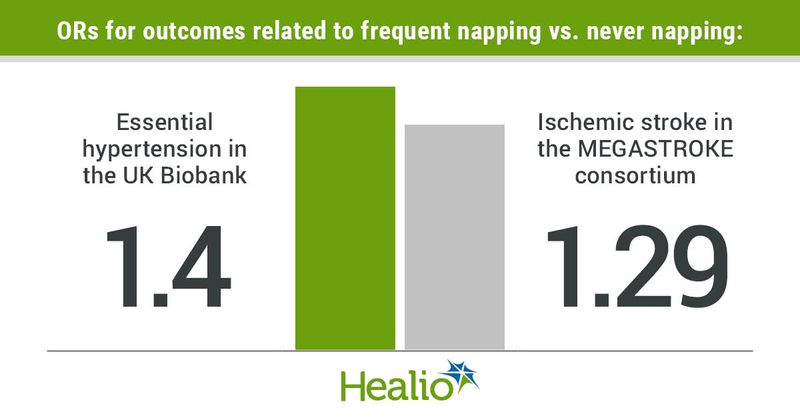Frequent daytime naps potential causal risk factor for hypertension, ischemic stroke
Adults who reported taking frequent daily naps had greater risk for essential hypertension and stroke compared with those who never or rarely nap, researchers reported.
Participants who napped more frequently were also more likely to have poorer social determinants of health, more comorbidities and more self-reported sleep problems such as insomnia, snoring or evening chronotype, according to data published in Hypertension.

“These results are especially interesting since millions of people might enjoy a regular, or even daily, nap,” E. Wang, PhD, MD, professor and chair of the department of anesthesiology at Xiangya Hospital Central South University in Hunan, China, said in a press release.
“This may be because, although taking a nap itself is not harmful, many people who take naps may do so because of poor sleep at night. Poor sleep at night is associated with poorer health, and naps are not enough to make up for that,” Michael A. Grandner, PhD, MTR, director of the Sleep and Health Research Program and the Behavioral Sleep Medicine Clinic, associate professor of psychiatry at the University of Arizona in Tucson and co-author of the American Heart Association’s new Life’s Essential 8 CV health score, said in the release. “This study echoes other findings that generally show that taking more naps seems to reflect increased risk for problems with heart health and other issues.”
Sleep duration was added to the AHA’s Life’s Simple 7 tool in June as the eighth metric for optimal CV and brain health.
As Healio previously reported, the updated checklist that now includes sleep health metrics showed about 80% of Americans have low to moderate CV health, with the largest gaps noted in diet, physical activity and BMI.
Daily napping and risk
To better understand the relationship between the frequency of daytime napping and the incidence of essential hypertension or stroke, researchers in China assessed the data of 358,451 participants in the UK Biobank free of hypertension or stroke at baseline (mean age, 55 years, 43% men). The median follow-up duration was 11.16 years.
Daytime napping was self-reported with the following responses: never/rarely, sometimes, usually or prefer not to answer.
The researchers observed individuals who reported usually napping had higher risk for essential hypertension (HR = 1.12; 95% CI, 1.08-1.17), stroke (HR = 1.24; 95% CI, 1.1-1.39) and ischemic stroke (HR = 1.2; 95% CI, 1.05-1.36) compared with individuals who reported never or rarely napping.
Risk for essential hypertension, stroke and ischemic stroke was slightly lower among those who reported sometimes napping compared with usually napping but remained elevated compared with never/rarely napping.
The researchers noted that people who reported daytime napping were more likely to be men, older, non-European, less educated; to have lower income, higher BMI, higher waist-hip ratio, higher Townsend deprivation index; and to have a history of smoking, psychiatric disorder, high cholesterol and diabetes. Individuals who reported daytime napping were also more likely to sleep longer at nighttime and reported sleep problems, including insomnia, snoring or evening chronotype.
Validation using Mendelian randomizations
To validate these results, researchers conducted a two-sample Mendelian randomization for the association between daytime napping frequency and essential hypertension using the FinnGen Biobank, and stroke and ischemic stroke were validated using the MEGASTROKE consortium and a corresponding one-sample Mendelian randomization.
In both the one- and two-sample Mendelian randomizations, researchers reported that increased daytime napping frequency was linked in a causal manner to risk for essential hypertension in the FinnGen Biobank (OR = 1.43; 95% CI, 1.06-1.92) and UK Biobank (OR = 1.4; 95% CI, 1.28-1.58).
Moreover, the results of the two-sample Mendelian randomization in the MEGATROKE also validated daytime napping frequency as a potential causal risk factor for ischemic stroke (OR = 1.29; 95% CI, 1.04-1.62).
“The specific biological mechanism for the effect of daytime napping on BP regulation or stroke has not yet been discovered. The underlying mechanisms are poorly understood but may include increased inflammatory indices or the long-term effect of a BP peak after a daytime nap,” the researchers wrote. “Our study, along with previous clinical studies, suggests that further examination of the mechanistic basis of the association between a healthy sleep pattern, including daytime napping, and cardiovascular disease is necessary.”
Reference:
- Study shows link between frequent naps and high blood pressure. newsroom.heart.org/news/study-shows-link-between-frequent-naps-and-high-blood-pressure. Published July 25, 2022. Accessed July 25, 2022.

